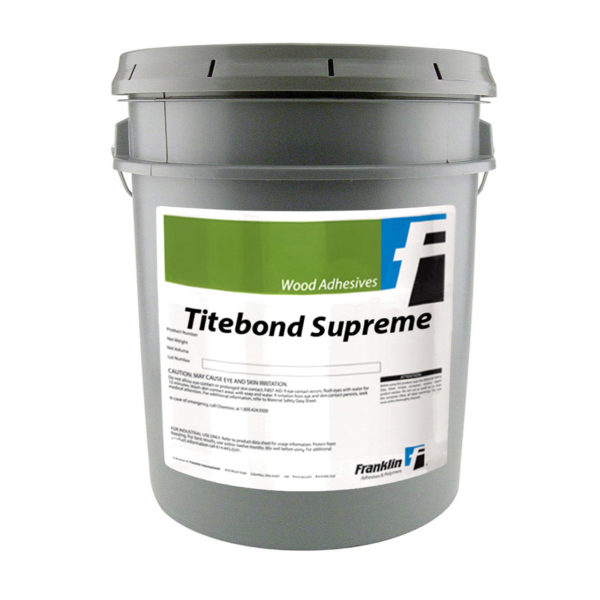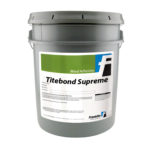

Titebond Supreme
This is a very fast setting adhesive of the titebond aliphatic resin range. It is Specifically formulated to provide short clamp time for oak and other ring-porous woods. It has excellent heat and solvent resistance and excellent durability for interior exposures. Excellent for Ash and Oak high volume production.
Where to buyFeatures
- Excellent heat and solvent resistance
- Best for Ring porous hardwoods (USA Oak & Tas oak / Vic ash)
- Setting speed: medium
- Minimal or no joint creep
- Formaldehyde-free
- Superior performance history with interior furniture
- One component great for cold pressing and assembly
- 175.105 FDA compliant
- Low minimum use temperature
Resources
- MSDS (PDF, 127.70kB)
- Data Sheet (PDF, 59.79kB)
| Part number | Size | Weight | UPC | Case UPC | Units per package | Packages per pallet |
| 513128 | 19lt Pail | 21.1kg | 1 | 24 |
| Type | Aliphatic resin emulsion adhesive |
| State | Liquid |
| Colour | Yellow |
| Dried film | Yellow |
| Solids | 44% |
| Viscosity | 4,000 cps |
| Storage life | 12 minths in tightly closed containers at -6.6°C |
| Weight per gallon | 4.08kg |
| Chalk temperature | N/A |
| Flashpoint | N/A |
| Freeze/thaw stability | Unstable |
| pH | 4.2-5.0 |
Edge or face gluing of solid lumber stock can present a unique challenge for adhesives. The adhesive must be rigid enough to withstand the applied stresses found under variable service conditions. Additionally, properly prepared adhesive joints are very important to successful gluing.
Moisture Content
Six to eight percent is the recommended moisture content for the gluing stock. High moisture content will dramatically increase the clamp time needed. Additionally, panel shrinkage may occur
resulting in stress cracks or end joint delamination.
Stock Preparation
The preparation of the stock to be glued is extremely important. Joints cut from rip saws should be free of saw marks. They should also be straight and square. Moulded or jointed stock should be free of knife marks. Glazed or burnished joints will prevent adhesive penetration and should be guarded against. When possible, glue joints should be prepared and glued the same day.
Tolerances
Gluing stock should be uniform in thickness. Variation in thickness should not exceed ±.005 inches. Sanding to thickness should be performed using higher than 50 grit abrasives. Bowing of staves used in edge gluing should be kept to a minimum, typically less than 1/16″ end to end.
Spread
Generally, 35-50 pounds of adhesive per 1,000 square feet of glue line is adequate. Conveyorized spreaders are commonly used in this application. The use of a wool felt sleeve on the spreader roll can aid in obtaining a desirable spread and reducing excess glue usage.
Assembly Time
Assembly time can vary greatly depending on the adhesive used, glue spread, porosity and moisture content of stock, environmental conditions, etc. A small bead of adhesive squeeze-out around the
perimeter of the bottom panel in the stack is desirable. Generally accepted assembly time is 5-10 minutes.
Pressure
Pressure is dependent upon the species or material to be glued and joint preparation. Direct contact of the gluing surfaces must be made to obtain maximum strength. Suggested pressures for various
wood densities are: low 100-150 psi; medium 125-175 psi; high 175-250 psi. Clamps for edge gluing should be spaced 8-12 inches apart and 2 inches from the end of the panel to evenly distribute pressure along the entire length of the glue line. The use of a compressometer will aid in accurately measuring the amount of pressure being applied to the gluing area.
Press Time
Press time is dependent on the adhesive used, gluing stock type, moisture content of the stock and environmental conditions. Typical press times range from 30 minutes to two hours. Press times should be determined under plant conditions. The speed of set indicator on Franklin Product Data Sheets is the best starting point for determining the time that should be allowed for pressing/clamping and assembly. As a general rule of thumb, the higher the number, the shorter the press/clamp and assembly time should be. The lower the number, the longer the press/clamp and assembly time can be.
Post Press Conditioning
After a minimum clamping period, the panel will develop enough handling strength to permit it to be removed from the press. An overnight cure is recommended prior to machining. A storage
period of 3-4 days may be required to eliminate sunken joints caused by residual moisture in the glue line.
Clean Up
To easily remove Franklin adhesive from your equipment while it is still wet, use water. Warm water will soften dried glue, however steam will soften it more rapidly. Cleaning clamps, jigs, press platens and fixtures is much easier if equipment is regularly coated with a glue release agent, wax or soap before using it.
These release agents prevent the adhesive from sticking to the equipment and will help dried glue to flake or chip off quickly and easily.